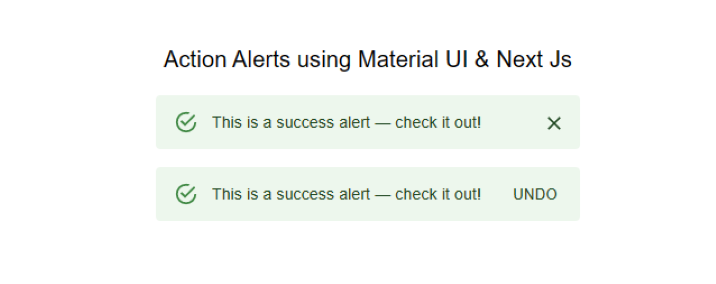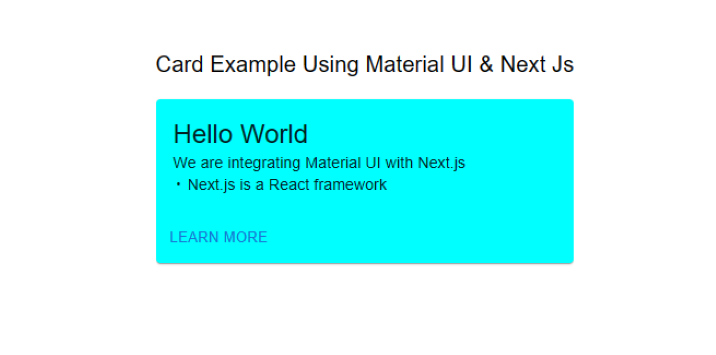如何在Next.js中使用Material-UI
Material-UI是一个流行的基于React的UI库,提供了广泛的UI组件和设计元素。Next.js是一个基于React的框架,用于构建服务器端渲染(SSR)和静态导出的Web应用程序。在本教程中,我们将学习如何使用Material-UI与Next.js创建一个用户友好、现代和响应式的用户界面。
将Material-UI与Next.js集成的步骤
用户可以按照以下步骤使用Material-UI与Next.js。
步骤1 - 通过以下命令创建一个新的Next.js项目 –
npx create-next-app my-app
步骤2 - 导航到新创建的项目文件夹 –
cd my-app
步骤3 - 运行以下命令安装Material-UI –
npm install @mui/material @emotion/react @emotion/styled
步骤4 − 在 Next.js 页面中导入 Material-UI 组件。例如,我们可以按以下方式导入 Material-UI 的 Button 组件:
import Button from '@mui/material/Button';
步骤5 − 在 Next.js 页面中使用导入的 Material-UI 组件。例如,用户可以使用以下方式使用 Button 组件:
<Button variant="contained" color="primary">
Click Me!
</Button>
步骤6 − 要添加一个 Material-UI 主题,请先导入 createTheme 函数 −
import { createTheme } from '@mui/material/styles';
步骤7 − 创建一个主题对象 −
const theme = createTheme({
palette: {
primary: {
main: '#1976d2',
},
},
});
步骤8 − 现在我们需要将整个Next.js应用程序包装在一个ThemeProvider组件中,并将主题对象作为prop传递 −
import { ThemeProvider } from '@mui/material/styles';
function MyApp({ Component, pageProps }) {
return (
<ThemeProvider theme={theme}>
<Component {...pageProps} />
</ThemeProvider>
);
}
这就是全部!现在我们已经将Material-UI的组件和主题集成到了我们的Next.js应用中。
示例
在这个示例中,我们使用了Material-UI来创建两个警报。代码以import语句开头,该语句导入了我们需要的必要的React库和Material-UI组件。
接下来,我们定义了组件”ActionAlerts”。这个组件使用了Material-UI的Stack组件来显示两个警报。Stack组件定义了宽度为100%和间距为2个单位。
第一个警报使用了Material-UI的Alert组件来定义。这个警报的消息是”This is a success alert — check it out!”,没有定义任何操作。
第二个警报也使用了Alert组件来定义。这个警报的消息是”This is a success alert — check it out!”,并定义了一个操作,即一个按钮,上面写着”UNDO”。
这段代码演示了如何在Next.js中使用Material-UI创建警报,以提供用户反馈或显示重要信息。
import * as React from 'react';
import Alert from '@mui/material/Alert';
import Button from '@mui/material/Button';
import Stack from '@mui/material/Stack';
import { Typography } from '@mui/material';
export default function ActionAlerts() {
return (
<>
<Typography sx= {{textAlign: "center",mb: "1rem"}} >Action Alerts</Typography>
<Stack sx= {{ width: '100%' }} spacing= {2} >
<Alert onClose={() => {}}> This is a success alert — check it out! </Alert>
<Alert
action={
<Button color = "inherit" size = "small" >
UNDO
</Button>
}
>
This is a success alert — check it out!
</Alert>
</Stack>
</>
);
}
输出

示例
这是一个将Material-UI与Next.js集成的另一个示例。该示例创建了一个简单的卡片组件,显示一个问候消息,并包括一个”了解更多”按钮。
步骤1 - 代码首先从Material-UI库中导入所需的依赖项。这些包括Box、Card、CardActions、CardContent、Button和Typography组件。
步骤2 - 使用Box组件定义了bull常量。该组件用于显示一个圆点字符(•),用于分隔卡片中的两行文本。
步骤3 - 将Mui组件定义为此文件的默认导出。
步骤4 - 然后定义Card组件,使用minWidth和backgroundColor属性设置卡片的宽度和背景颜色。
步骤5 - 使用CardContent组件显示问候消息”Hello World”。
步骤6 - 使用CardActions组件显示一个带有文本”Learn More”的按钮。
总的来说,这段代码演示了如何在Next.js中使用Material-UI组件创建一个简单的卡片组件。使用了Material-UI的Box、Card、CardActions、CardContent、Button和Typography组件来创建一个外观精美且功能齐全的卡片组件。
import * as React from 'react';
import Box from '@mui/material/Box';
import Card from '@mui/material/Card';
import CardActions from '@mui/material/CardActions';
import CardContent from '@mui/material/CardContent';
import Button from '@mui/material/Button';
import Typography from '@mui/material/Typography';
// Create a bullet point character for use in the CardContent component
const bull = (
<Box
component="span"
sx={{ display: 'inline-block', mx: '2px', transform: 'scale(0.8)' }}
>
</Box>
);
// The default export of this file, the Mui component
export default function SimpleCard() {
return (
// A typography component to display a heading
<Typography variant = "h6" component = "div" sx = {{marginBottom:"1rem"}}>
Card Example Using Material UI & Next Js
</Typography>
// A Card component with specific styles applied
<Card sx={{ minWidth: 275, backgroundColor:`aqua` }}>
<CardContent>
{/* A typography component to display the greeting message */}
<Typography variant = "h5" component = "div">
Hello World
</Typography>
{/* A typography component to display the description of the example */}
<Typography variant = "body2">
We are integrating Material UI with Next.js
<br />
{/* Use the bull constant to separate the two lines of text */}
{bull} Next.js is a React framework
</Typography>
</CardContent>
{/* A CardActions component to display the "Learn More" button */}
<CardActions>
<Button size = "small" > Learn More </Button>
</CardActions>
</Card>
);
}
现在将自定义的卡片组件添加到一个Next.js页面中−
import SimpleCard from './SimpleCard';
function HomePage() {
return (
<div>
<SimpleCard />
</div>
);
}
export default HomePage;
输出

在本教程中,我们学习了如何使用Material-UI与Next.js来创建现代和响应式的用户界面。Material-UI提供了各种UI组件和设计元素,可以轻松集成到Next.js应用程序中。通过其强大的样式系统,Material-UI使得为我们的Next.js应用程序创建自定义主题和样式变得容易。我们希望本教程能帮助用户开始使用Material-UI与Next.js。
 极客笔记
极客笔记